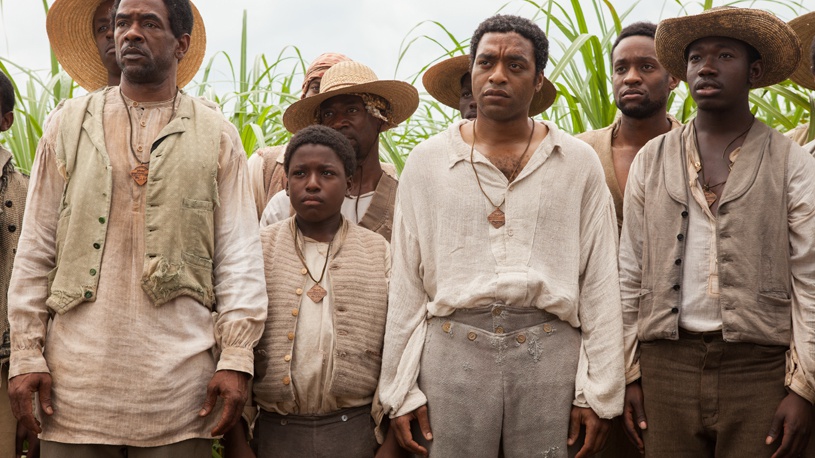
The opening scene. Chiwetel Ejiofor (middle) plays the character Solomon. Source: Official Fox Searchlight Pictures image
From beginning to end, “12 Years a Slave” is difficult to watch. It makes you feel like you are learning the true horror of slavery for the first time because no effort has been made to play down its violence and brutality, which past feature films about slavery have done. There are scenes which make you wince and others which are almost impossible to watch. Contrasted with beautiful screen shots of the South’s natural landscape, the crimes of slavery – including rape and murder – appear even uglier. It is still hard to believe that slavery occurred in the United States, the country everyone associates with democracy, well into the nineteenth century, and so, “12 Years a Slave” comes as a shocking reminder of the dark history America would rather forget.
The film is based on an autobiography of the same name which was published in 1853 by Solomon Northup, a free black man who was kidnapped in Washington, D.C. in 1841 and sold into slavery. Solomon, after being drugged, wakes up one day to find that he has been taken to the South to work on a plantation. The initial scenes show Solomon with his family and friends, well-dressed, going about his day-to-day life. So, when the screen suddenly changes to Solomon confusedly feeling the chains on his hands and feet, which were not there last time he was awake, viewers are forced to experience how surreal and absolutely terrifying it must have been to find himself now a slave.
By focusing on a single slave (Solomon) for most of the film and his transition from freedom to slavery, and eventually freedom again, viewers begin to really understand the psychological damage of slavery. Solomon is forced to accept a completely new identity and lifestyle that are entirely alien to him – he is told that he is not Solomon and beaten for using his real name. The dehumanizing nature of slavery is one of the film’s main themes and slavery is shown to have reduced the humanity of both masters and slaves. The slave masters are depicted as animalistic because they can inflict so much pain, or death, upon other human beings without feeling any guilt or shame. The slaves, on the other hand, become less human as they set about their work like machines, forbidden basic human rights. A particularly striking scene is when one of the older slaves dies and Solomon stands over the grave with two other slaves. As Solomon begins filling the grave with dirt one of the others stops him because he wants to say a few words in honor of the dead man first. Here Solomon is shown to have become numb to death, which happens so regularly among the slaves, and it seems that he has forgotten that the buried man meant something to someone. Slavery has forced him into the mindset that slaves are like livestock: when one dies another is bought to replace them.
The film also pays attention to the role religion played in slavery, for both the slaves and the slave masters. Solomon’s first master, William Ford (Benedict Cumberbatch) holds church service for his slaves, reading the Bible to them outside. The hypocrisy of a Christian slave master is highlighted by the fact that as he reads one of the slave women, Eliza, is crying throughout, over his voice. She has recently been bought by master Ford, who watched her be separated from her children. Solomon’s next master Edwin Epps (Michael Fassbender), who is notoriously cruel toward his slaves, uses religious scripture to assure himself that there is no injustice in how he treats his slaves since he does not view them as humans, but as property.
Religion is even more important to the slaves, who sing spirituals and hymns as they labor, to maintain their hope for a better day and salvation. A memorable scene from the film is the funeral of one of the slaves. All the slaves are gathered around the grave singing the spiritual “Roll Jordan Roll” and the camera focuses on Solomon, who is not singing, but is clearly struggling with himself. It seems he cannot decide whether he to remain faithful, considering there are no signs that God is taking care of him or his fellow slaves. The camera stays on Solomon, and it seems that he isn’t going to join in; but finally his lips move and we hear his individual voice singing among the rest. This part of the film, along with others, highlights how important religion was to slaves, helping them to survive when they had nothing else.
The film concentrates mainly on Solomon’s story but brings in a wide range of characters, showing different aspects of slavery and how it was not a single, unified experience for those involved. The horrors of slavery particular to female slaves, for example, are conveyed through the characters of Patsy (Lupita Nyong’o), Mistress Shaw (Alfre Woodard) and Eliza (Adepero Oduye). Patsy is not only raped by her master but also punished by her mistress, who sees how her husband finds Patsy attractive and treats her favorably over the other slaves. Eliza, a mother, is inconsolable with grief after she is separated from her two children, who are not bought by her new owner. Mistress Shaw, a black woman married to a white slave plantation owner, describes the trauma she suffered in order to escape picking cotton herself.
Undoubtedly, “12 Years a Slave” will provoke mixed reactions in America, especially in the South. The film’s raw treatment of slavery – which film directors have traditionally shied away from for fear of low sales – has led the New York Times to describe it as “box office test-case.” The film is directed by Steve McQueen, a Black British director, and one of the questions that has already been raised in light of the film is, why has it taken a British director, rather than an American, to finally portray the atrocities of slavery in an unrestrained way? Is slavery still a taboo topic for Americans? If so, why?
Author: Greta Tugwell
Nommo Staff
